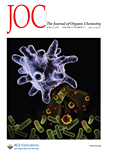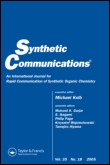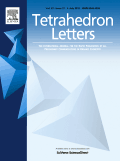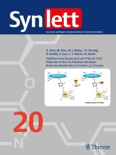
JOURNAL OF ORGANIC CHEMISTRY
Scope & Guideline
Fostering Excellence in Organic Chemistry Research
Introduction
Aims and Scopes
- Organic Synthesis:
The journal extensively covers research on the synthesis of organic compounds, exploring new synthetic methodologies, reaction mechanisms, and applications in various fields, including medicinal and materials chemistry. - Catalysis:
A significant focus on catalytic processes, including transition metal-catalyzed reactions, organocatalysis, and photocatalysis, which are crucial for efficient organic transformations and sustainable chemistry. - Functionalization of Organic Molecules:
Research on the functionalization of organic molecules, particularly through C-H activation and other innovative strategies to introduce functional groups into complex organic frameworks. - Heterocyclic Chemistry:
A dedicated area of research involving the synthesis and study of heterocyclic compounds, which are pivotal in pharmaceuticals and agrochemicals. - Material Chemistry:
Exploration of organic materials, including the synthesis of polymers, organic semiconductors, and fluorescent compounds, highlighting their applications in electronics, photonics, and bioimaging. - Mechanistic Studies:
The journal emphasizes the importance of understanding reaction mechanisms, providing insights into the behavior of organic compounds during chemical transformations.
Trending and Emerging
- Sustainable Chemistry:
There is a growing emphasis on sustainable and green chemistry practices, including the use of renewable resources, reduction of hazardous solvents, and energy-efficient processes. - Photocatalysis and Photoredox Chemistry:
Research in photocatalysis has surged, with studies focusing on light-driven reactions that offer new pathways for organic synthesis, particularly in the context of sustainability. - Electrochemical Synthesis:
Electrochemical methods for organic synthesis are gaining popularity as they offer environmentally friendly alternatives to traditional methods, allowing for direct transformations without the need for stoichiometric reagents. - C-H Activation and Functionalization:
The field of C-H activation is rapidly evolving, with new strategies being developed to functionalize hydrocarbons, which is crucial for the synthesis of complex molecules. - Asymmetric Synthesis:
There is an increasing interest in asymmetric synthesis techniques, particularly those employing new catalysts and methodologies to achieve high enantioselectivity in organic transformations. - Material Science and Organic Electronics:
The synthesis and study of organic materials for applications in electronics and photonics, including organic semiconductors and sensors, are emerging as significant areas of research.
Declining or Waning
- Traditional Organic Synthesis Techniques:
There is a noticeable shift away from classical organic synthesis methods towards more innovative, sustainable approaches, such as green chemistry and photoredox catalysis. - Non-Catalytic Reactions:
Research focusing on non-catalytic reactions is declining as the field moves towards more efficient and sustainable catalytic processes. - Synthesis of Simple Organic Compounds:
The journal is increasingly prioritizing complex organic synthesis over simpler compounds, leading to fewer publications on straightforward organic reactions. - Conventional Solvent-Based Reactions:
There is a decreasing emphasis on traditional solvent-based reactions, with more researchers exploring solvent-free and eco-friendly alternatives.
Similar Journals

SYNTHETIC COMMUNICATIONS
Advancing the Art of Synthesis in Organic ChemistrySynthetic Communications, published by Taylor & Francis Inc, stands as a pivotal resource in the field of organic chemistry since its inception in 1971. With an ISSN of 0039-7911 and an E-ISSN of 1532-2432, this journal has established a commendable reputation, holding a Q3 ranking in organic chemistry by 2023, reflecting its contributions to the discipline and positioning it within the 50th percentile according to Scopus rankings. Targeted towards researchers, professionals, and students alike, Synthetic Communications aims to disseminate significant advancements in synthetic methodologies and reactions, facilitating the exchange of innovative ideas and enhancing collaborative efforts in the scientific community. Although not an open-access journal, it offers a wealth of valuable research content that is crucial for anyone dedicated to pushing the boundaries of organic chemistry.

TETRAHEDRON LETTERS
Advancing the Frontiers of Chemical KnowledgeTETRAHEDRON LETTERS, published by Pergamon-Elsevier Science Ltd, is a leading journal in the fields of Biochemistry, Drug Discovery, and Organic Chemistry, with a rich legacy since its inception in 1959. This prestigious journal serves as a vital resource for researchers and professionals dedicated to advancing the understanding of chemical sciences, featuring high-impact research that influences both academic and practical applications. Although it is currently classified in the third quartile across its categories for 2023, its rigorous peer-review process ensures the publication of quality research that contributes to the scientific community. With an ISSN of 0040-4039 and an E-ISSN of 1873-3581, TETRAHEDRON LETTERS is easily accessible for those in the academic landscape seeking to stay abreast of innovative developments. Researchers, professionals, and students alike will find invaluable insights and collaborative opportunities within the pages of TETRAHEDRON LETTERS, making it an essential read for anyone involved in the chemical sciences.

ALDRICHIMICA ACTA
Advancing the Frontiers of Organic ChemistryALDRICHIMICA ACTA is a prestigious journal published by Aldrich Chemical Co Inc, focusing on the dynamic field of organic chemistry. With an impressive H-index and a strong Scopus rank of #38 out of 211 journals, this quarterly publication has established itself in the Q1 quartile of organic chemistry, a testament to its influence and relevance in research. The journal, which has been in circulation since 1990, disseminates high-quality research articles, reviews, and practical insights tailored for chemists, researchers, and industry professionals. While the journal operates under a subscription model, it remains a crucial resource for staying updated with the latest advancements and methodologies in organic chemistry. Located in Milwaukee, Wisconsin, ALDRICHIMICA ACTA continues to contribute significantly to the field, promoting excellence in scientific communication and collaboration.

SYNLETT
Unveiling Breakthroughs in Organic Compound ResearchSYNLETT is a prominent academic journal dedicated to the field of Organic Chemistry, published by GEORG THIEME VERLAG KG. Since its inception in 1989, the journal has played a critical role in advancing the understanding of synthetic methodologies and organic compounds, offering a platform for innovative research and discoveries. With an ISSN of 0936-5214 and an E-ISSN of 1437-2096, SYNLETT is well-regarded in the academic community, presently positioned in the Q3 quartile for Organic Chemistry according to the 2023 category rankings. The journal is particularly valuable for researchers and professionals seeking insights into contemporary organic synthesis methods and their applications. Although it does not operate under an Open Access model, it remains a crucial resource within the field, contributing to significant advancements and collaborations globally. For those engaged in organic synthesis, SYNLETT not only encapsulates cutting-edge research but also inspires innovation in the discipline.

ORGANIC SYNTHESES
Championing Rigorous Research in Organic SynthesisORGANIC SYNTHESES is a prestigious journal dedicated to the field of organic chemistry, published by ORGANIC SYNTHESES INC. Since its inception in 1946, the journal has served as a vital platform for researchers, educators, and practitioners in chemistry, showcasing significant findings and methodologies that advance the discipline. Although it currently does not offer open access, it is recognized for its rigorous peer-review process and its contribution to standardizing organic synthesis methods. With an ISSN of 0078-6209 and an E-ISSN of 2333-3553, the journal's impact reflects its quality, with a current Scopus ranking placing it in the fourth quartile in both Organic Chemistry and Physical and Theoretical Chemistry. This positioning underscores its critical role in fostering knowledge and innovation within these fields. Researchers and students alike will find ORGANIC SYNTHESES an essential resource for staying informed on contemporary practices and discoveries in organic synthesis.

Asian Journal of Organic Chemistry
Exploring the depths of organic chemistry excellence.Asian Journal of Organic Chemistry, published by WILEY-V C H VERLAG GMBH, stands as a pivotal platform in the realm of organic chemistry, catering to researchers and professionals eager to share their contributions to the field. With an ISSN of 2193-5807 and E-ISSN of 2193-5815, this journal spans a commendable convergence from 2012 to 2024, featuring a notable impact factor highlighted by its Q2 ranking in the 2023 Organic Chemistry category. Positioned at rank #94 out of 211 in Scopus, the journal emphasizes the importance of quality research and innovation in organic chemistry. The lack of open access enhances the journal's selectivity, ensuring only the most rigorous and impactful studies are published. Serving as a vital resource for scholars, students, and practitioners alike, the Asian Journal of Organic Chemistry fosters the dissemination of knowledge, advances academic dialogue, and reinforces the pivotal role of organic chemistry in scientific advancement.

Nature Synthesis
Innovating Materials Science for a Sustainable FutureNature Synthesis, published by SpringerNature, is a premier peer-reviewed journal dedicated to advancing the field of synthesis in chemistry and materials science. With an impressive impact factor and categorized in the Q1 quartile for Chemistry (miscellaneous), Inorganic Chemistry, Materials Chemistry, and Organic Chemistry, it ranks prominently among its peers, reflecting its high-quality research output and relevance.
This journal provides a platform for researchers, professionals, and students to publish innovative synthesis methodologies, novel materials, and interdisciplinary approaches that push the boundaries of chemistry. Operating under an Open Access model, it ensures that research is widely accessible, fostering collaboration and engagement across the global scientific community.
Situated in the United Kingdom, Nature Synthesis is committed to contributing to the scientific discourse from 2022 to 2024, and beyond, as it continues to highlight significant advancements across chemistry domains.

Organic Chemistry Frontiers
Connecting scholars to the latest in organic chemistry.Welcome to Organic Chemistry Frontiers, a premier academic journal published by the Royal Society of Chemistry, dedicated to advancing the field of organic chemistry. With an impressive Q1 ranking in the 2023 category of Organic Chemistry and a notable Scopus rank of 34 out of 211, this journal provides a vital platform for researchers and professionals to disseminate innovative research, cutting-edge methodologies, and comprehensive reviews. Serving as an open-access journal, Organic Chemistry Frontiers aims to enhance the visibility and accessibility of critical research findings in the organic chemistry domain, fostering collaboration and dialogue among scientists worldwide. Since its inception in 2014, it has consistently published high-quality articles that contribute to the progression of knowledge and application in organic chemistry, establishing itself as a cornerstone for students and scholars striving to deepen their understanding and drive forward their research endeavors.

SynOpen
Empowering Open Access for Scientific ProgressSynOpen is an esteemed open-access journal published by GEORG THIEME VERLAG KG, based in Germany, dedicated to advancing the fields of Biomaterials, Catalysis, Materials Science, and Organic Chemistry. Since its inception in 2017, the journal has established itself as a vital platform for researchers wishing to disseminate their findings in a rapidly evolving scientific landscape, earning a commendable Q2 ranking in Materials Science (miscellaneous) and Q3 in other key categories for 2023. With an increasing impact on its disciplines, SynOpen aims to foster interdisciplinary collaboration and innovation by providing unrestricted access to high-quality research, thus promoting a broader reach and visibility for authors. Scholars, professionals, and students alike can benefit from the comprehensive range of topics covered, as the journal's commitment to presenting cutting-edge studies and methodologies positions it as a crucial resource for contemporary scientific inquiry.

ORGANIC & BIOMOLECULAR CHEMISTRY
Pioneering discoveries at the intersection of organic and biomolecular chemistry.ORGANIC & BIOMOLECULAR CHEMISTRY is a prestigious academic journal published by the Royal Society of Chemistry, dedicated to advancing the fields of organic and biomolecular chemistry. With its ISSN of 1477-0520 and E-ISSN of 1477-0539, this journal plays a pivotal role in disseminating high-quality research and contributing to the scientific community, particularly in biochemistry, organic chemistry, and physical and theoretical chemistry. Currently ranked in the third quartile for Biochemistry and the second quartile for Organic Chemistry and Physical and Theoretical Chemistry, it caters to a diverse audience of researchers, professionals, and students who seek insightful studies and reviews. With a publication history spanning since 2003 and ongoing till 2024, the journal fosters open access to its articles, encouraging the free exchange of knowledge. Situated in the vibrant academic environment of Cambridge, UK, ORGANIC & BIOMOLECULAR CHEMISTRY serves as a vital resource for innovative research at the intersection of chemical sciences.